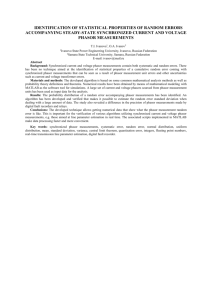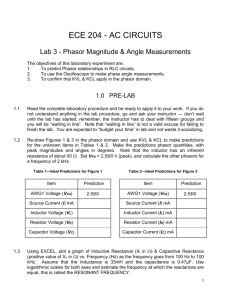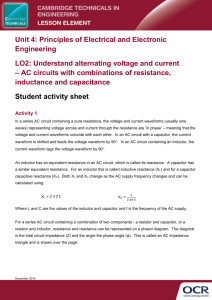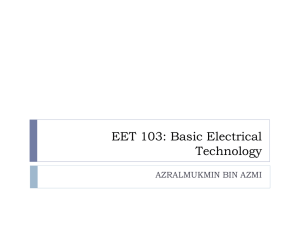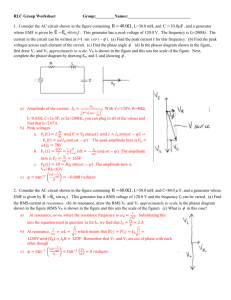SUMMARY V I R
advertisement
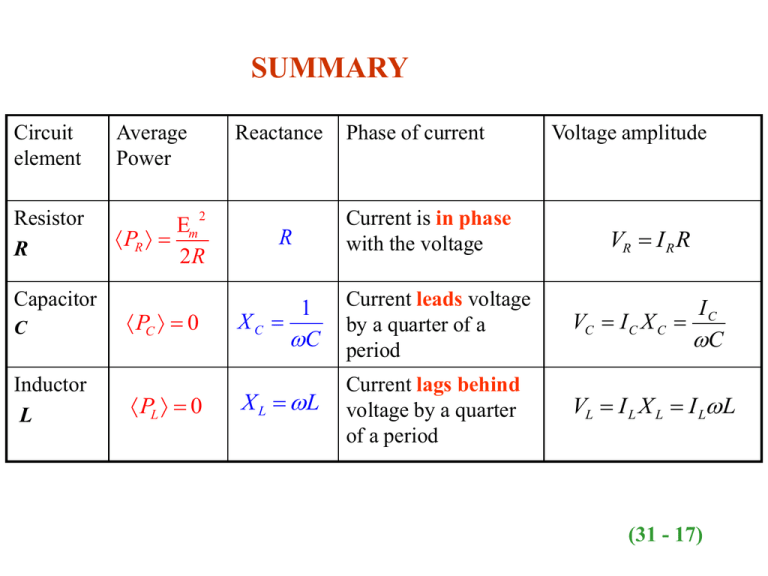
SUMMARY Circuit element Average Power Resistor R E PR m 2R R PC 0 1 XC C Current leads voltage by a quarter of a period IC VC I C X C C X L L Current lags behind voltage by a quarter of a period VL I L X L I L L Capacitor C Inductor L Reactance 2 PL 0 Phase of current Current is in phase with the voltage Voltage amplitude VR I R R (31 - 17) (31 - 18) The series RCL circuit An ac generator with emf E Em sin t is connected to an in series combination of a resistor R, a capacitor C and an inductor L, as shown in the figure. The phasor for the ac generator is given in fig.c. The current in i I sin t this circuit is described by the equation: i I sin t The current i is common for the resistor, the capacitor and the inductor The phasor for the current is shown in fig.a. In fig.c we show the phasors for the voltage vR across R, the voltage vC across C , and the voltage vL across L. The voltage vR is in phase with the current i. The voltage vC lags behind the current i by 90. The voltage vL leads ahead of the current i by 90. A i I sin t B Z R2 X L X C O I 2 Em Z Kirchhoff's loop rule (KLR) for the RCL circuit: E vR vC vL . This equation is represented in phasor form in fig.d. Because VL and VC have opposite directions we combine the two in a single phasor VL VC . From triangle OAB we have: Em2 VR2 VL VC IR IX L IX C I 2 R 2 X L X C Em I The denominator is known as the "impedance" Z 2 2 R X L XC 2 of the circuit. I 2 2 2 Z R 2 X L X C The current amplitude I 2 Em Z Em 1 R2 L C 2 (31 - 19) i I sin t (31 - 20) 1 XC C A B Z R2 X L X C tan O X L XC R X L L From triangle OAB we have: tan 2 VL VC IX L IX C X L X C VR IR R We distinguish the following three cases depending on the relative values of X L and X L . 1. X L X C 0 The current phasor lags behind the generator phasor. The circuit is more inductive than capacitive 2. X C X L 0 The current phasor leads ahead of the generator phasor The circuit is more capacitive than inductive 3. X C X L 0 The current phasor and the generator phasor are in phase 1. Fig.a and b: X L X C 0 The current phasor lags behind the generator phasor. The circuit is more inductive than capacitive 2. Fig.c and d: X C X L 0 The current phasor leads ahead of the generator phasor. The circuit is more capacitive than inductive 3. Fig.e and f: X C X L 0 The current phasor and the generator phasor are (31 - 21) in phase 1 LC I res Em R Resonance In the RCL circuit shown in the figure assume that the angular frequency of the ac generator can be varied continuously. The current amplitude in the circuit is given by the equation: Em I The current amplitude 2 1 R2 L C 1 has a maximum when the term L 0 C 1 This occurs when LC The equation above is the condition for resonance. When its is satisfied I res Em R A plot of the current amplitude I as function of is shown in the lower figure. This plot is known as a "resonance curve" (31 - 22) 2 Pavg I rms R Pavg I rms Erms cos (31 - 23) Power in an RCL ciruit We already have seen that the average power used by a capacitor and an inductor is equal to zero. The power on the average is consumed by the resistor. The instantaneous power P i 2 R I sin t R 2 T The average power Pavg 1 Pdt T 0 1 T I 2R 2 2 Pavg I R sin t dt I rms R 2 T 0 E R Pavg I rms RI rms I rms R rms I rms Erms I rms Erms cos Z Z The term cos in the equation above is known as 2 the "power factor" of the circuit. The average power consumed by the circuit is maximum when 0 Transmission lines Erms =735 kV , I rms = 500 A (31 - 24) home Step-down transformer 110 V Step-up transformer T2 T1 R = 220Ω 1000 km Power Station Energy Transmission Requirements The resistance of the power line R Heating of power lines Pheat . R is fixed (220 in our example) A 2 I rms R This parameter is also fixed ( 55 MW in our example) Power transmitted Ptrans Erms I rms (368 MW in our example) In our example Pheat is almost 15 % of Ptrans and is acceptable To keep Pheat we must keep I rms as low as possible. The only way to accomplish this is by increasing Erms . In our example Erms 735 kV. To do that we need a device that can change the amplitude of any ac voltage (either increase or decrease) The transformer (31 - 25) The transformer is a device that can change the voltage amplitude of any ac signal. It consists of two coils with different number of turns wound around a common iron core. The coil on which we apply the voltage to be changed is called the "primary" and it has N P turns. The transformer output appears on the second coils which is known as the "secondary" and has N S turns. The role of the iron core is to insure that the magnetic field lines from one coil also pass through the second. We assume that if voltage equal to VP is applied across the primary then a voltage VS appears on the secondary coil. We also assume that the magnetic field through both coils is equal to B and that the iron core has cross sectional area A. The magnetic flux dP dB through the primary P N P BA VP NP A (eqs.1) dt dt dS dB The flux through the secondary S N S BA VS NS A (eqs.2) dt dt VS V P NS NP dP dB NP A (eqs.1) dt dt dS dB S N S BA VS NS A (eqs.2) dt dt If we divide equation 2 by equation 1 we get: dB NS A VS dt N S VS VP VP N A dB NP NS NP P dt P N P BA VP The voltage on the secondary VS VP NS NP If N S N P NS 1 VS VP We have what is known a "step up" transformer NP If N S N P NS 1 VS VP We have what is known a "step down" transformer NP Both types of transformers are used in the transport of electric power over large distances. (31 - 26) IS IP VS V P NS NP IS NS I P NP VS VP We have that: NS NP VS N P VP N S (eqs.1) If we close switch S in the figure we have in addition to the primary current I P a current I S in the secondary coil. We assume that the transformer is "ideal" i.e. it suffers no losses due to heating then we have: VP I P VS I S If we divide eqs.2 with eqs.1 we get: IS (eqs.2) VI VP I P S S IP NP IS NS VP N S VS N P NP IP NS In a step-up transformer (N S N P ) we have that I S I P In a step-down transformer (N S N P ) we have that I S I P (31 - 27) Hitt A generator supplies 100 V to the primary coil of a transformer. The primary has 50 turns and the secondary has 500 turns. The secondary voltage is: A. 1000 V B. 500 V C. 250 V D. 100 V E. 10V hitt The main reason that alternating current replaced direct current for general use is: A. ac generators do not need slip rings B. ac voltages may be conveniently transformed C. electric clocks do not work on dc D. a given ac current does not heat a power line as much as the same dc current E. ac minimizes magnetic effects


